Cloudaware and CloudZero are two top-tier options. I’ve rolled up my sleeves to break down how they handle daily spend breakdowns, blended vs. unblended views, on-prem + cloud hybrid cost allocation, integration with your CMDB and asset lifecycle data, and yes — pricing that won’t ambush your CFO.
Get to know Cloudaware and CloudZero
Before we start breaking down forecasts, tagging policies, or chasing another rogue EBS volume — let’s talk about the two FinOps tools that keep showing up in every serious multi-cloud setup: Cloudaware and CloudZero.
If you’re running hundreds (or thousands) of accounts across AWS, Azure, and GCP, juggling billing exports, and trying to explain rising Kubernetes costs to finance — this is your lane. These platforms aren’t just monitoring spend. They’re built to make FinOps real across teams.
Let’s get familiar.
Cloudaware
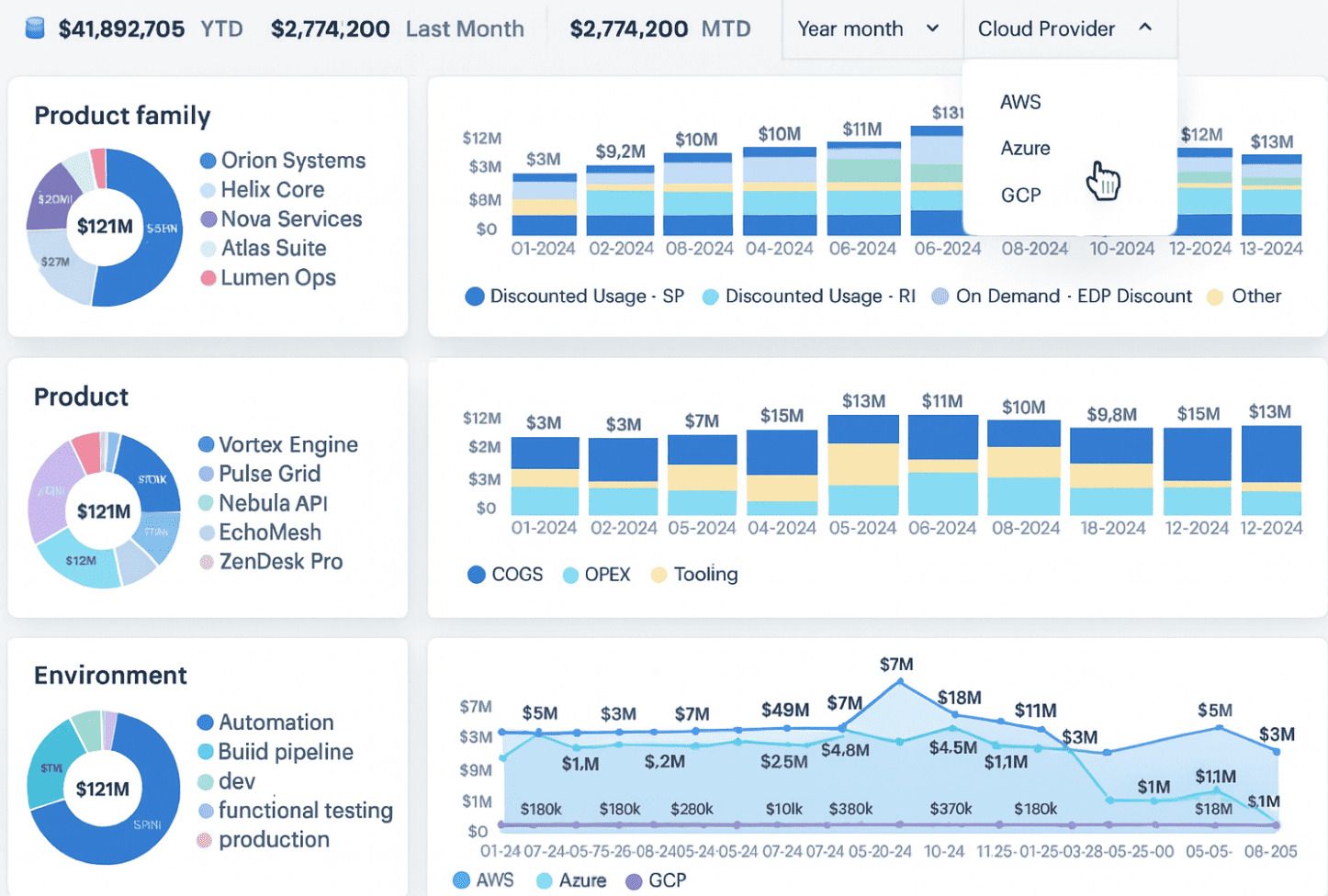
Cloudaware is for teams that need visibility with backbone. It’s built natively on Salesforce, which means it’s wired for automation, structure, and deep accountability.
Quick hits:
- Agentless setup — connects to AWS, Azure, GCP, Oracle, Alibaba through APIs.
- Pulls in billing, security, infra, and CMDB data — so you always know who owns what and why it costs money.
- Tracks cloud costs in real time, mapped to apps, services, regions, and environments
- Includes full ITAM support — cost by asset class, lifecycle, or even SLA compliance.
- Automates workflows with Force.com logic — think budget breaches triggering Jira tickets or idle resources flagged in your CMDB view.
Used by ops-heavy teams who care about ownership, reporting, and structured cost management that scales.
CloudZero
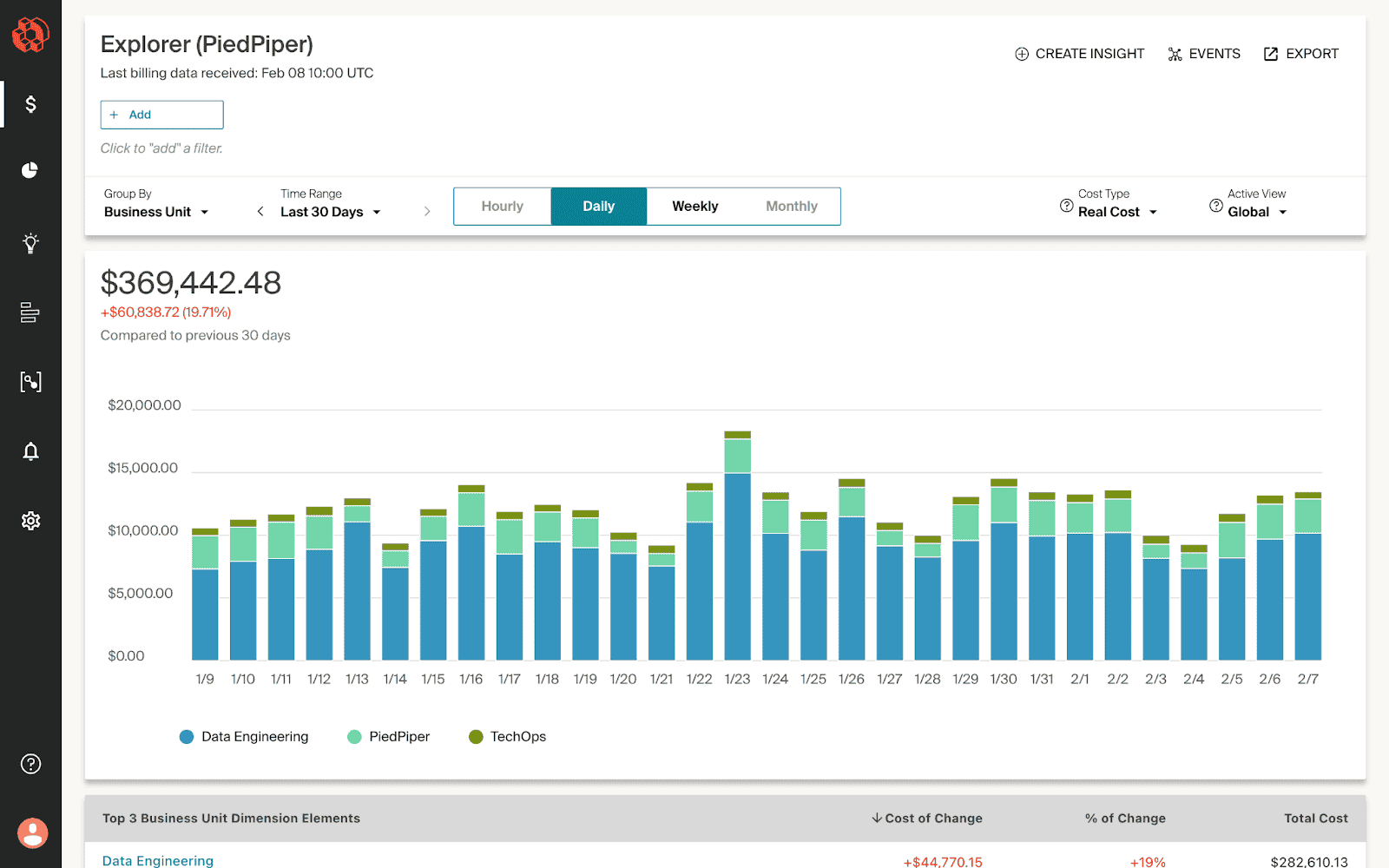
Image source.
CloudZero is designed for teams that move fast and don’t have time to clean up every tag. It doesn’t just show you what you’re spending — it tells you who’s spending it, why, and how to fix it.
Quick hits:
- Agentless + tag-agnostic — works even if tagging isn’t perfect (bless).
- Ingests spend from AWS, Azure, GCP, K8s, Snowflake, OpenAI, MongoDB — you name it.
- Real-time cost anomalies sent to Slack, email, or webhook, with context like “this feature just spiked”.
- Built-in Dimensions let you group cost by team, feature, product, or customer.
- Comes with ready-to-use dashboards like Cost per Sprint, Cost per Deploy, Budget vs. Actual — so teams don’t wait for a report.
Used by product-led orgs who want engineering, finance, and DevOps to speak the same cost language — in real time.
| FinOps Capability | Cloudaware | CloudZero |
|---|---|---|
| Supported Cloud Providers | AWS, Azure, GCP, VMware, Alibaba, Oracle Cloud, Kubernetes, Snowflake, MongoDB Atlas | AWS, Azure, GCP, Kubernetes, Snowflake, MongoDB, Databricks, OpenAI, etc. |
| Agentless Architecture | Yes (via API integrations) | Yes (via API integrations) |
| Billing Data Ingestion | AWS CUR, Azure EA, GCP billing exports | AnyCost™ engine ingests cloud + third-party SaaS billing data |
| Real-Time Data Processing | Real-time via cloud API polling | Real-time cost tracking + anomaly alerts |
| Anomaly Detection | Custom thresholds + Force.com alerts/workflows | Built-in anomaly detection, delivered via Slack/email/webhook |
| Forecasting & Budgeting | Dynamic forecasting, budget thresholds, escalation workflows | AI-driven forecasting, budget tracking via Dimensions, contextual alerts |
| Tagging & Allocation Support | You can tag any object within CMDB automatically and custom | Dimensions (feature, team, product), no need for perfect tags |
| Idle Resource Detection | Idle/underutilized resource views (e.g. EBS, RIs, snapshots) | Built-in waste detection with ownership context |
| Rightsizing Recommendations | Manual and rule-based rightsizing using CMDB relationships | Automated cost optimization via usage patterns + product impact |
| Dashboards & Visualization | Analytics Studio + Usage Analytics (custom widgets, CMDB enriched) | Prebuilt dashboards (e.g. cost per feature, team, deploy) + Dimensions views |
| Custom Reporting | Force.com Report Builder, SLA-based views, Excel/CSV/PDF exports | Scheduled exports (PDF, PNG, CSV), Slack delivery, webhook/API to BI tools |
| Chargeback & Showback | Unlimited. You can create any report if there is its cost data within CMDB | Cost per team/feature/customer via Dimensions |
| CMDB Integration | Native; links cost to infrastructure, ownership, SLA, ITAM lifecycle | Not CMDB-based |
| ITAM Reporting Support | Yes – cost tracking by asset lifecycle, depreciation, ownership, risk level | Not focused on ITAM |
| Workflow Automation | Apex + Force.com logic; triggers, tickets, escalations | API/webhook triggered alerts/actions |
| Integrations | 50+ integrations including Jira, ServiceNow, PagerDuty, New Relic, Snowflake, Datadog, etc. | Slack, Jira (via webhook), Zapier, Tableau, custom BI via API |
| Time to Value | 4–6 weeks (with CMDB/tag setup) | 1–2 weeks (Dimensions setup, source linking) |
| FinOps Support Model | Every client has a dedicated Technical Account Manager who provide personalized setup | Dedicated FinOps Account Manager (FAM) + guided onboarding |
| Best Fit For | Ops-led orgs with formal chargeback, ITAM, CMDB-driven governance | Product/engineering-led orgs seeking real-time cost awareness and agility |
You’ve met the platforms. You’re ready for the deep dive.
Visibility: unifying cloud cost insights across clouds
Not visibility in the “there’s a chart for that” sense. I’m talking actual cost truth — the kind that lets you answer: What are we spending? Who’s responsible? Is it worth it?
That’s where Cloudaware and CloudZero step in.
Cloudaware – FinOps visibility that thinks in context
Cloudaware’s whole thing is precision. It pulls in your AWS CUR, Azure EA, and GCP billing data, normalizes it daily, and gives you clear, tagged, and trackable cost breakdowns across clouds. So instead of “unknown compute resource in us-east-1,” you get “DevOps-Sandbox-EKS-Cluster-Beta.”
What helps most:
- Daily spend views auto-populate with accurate metadata (project, team, environment).
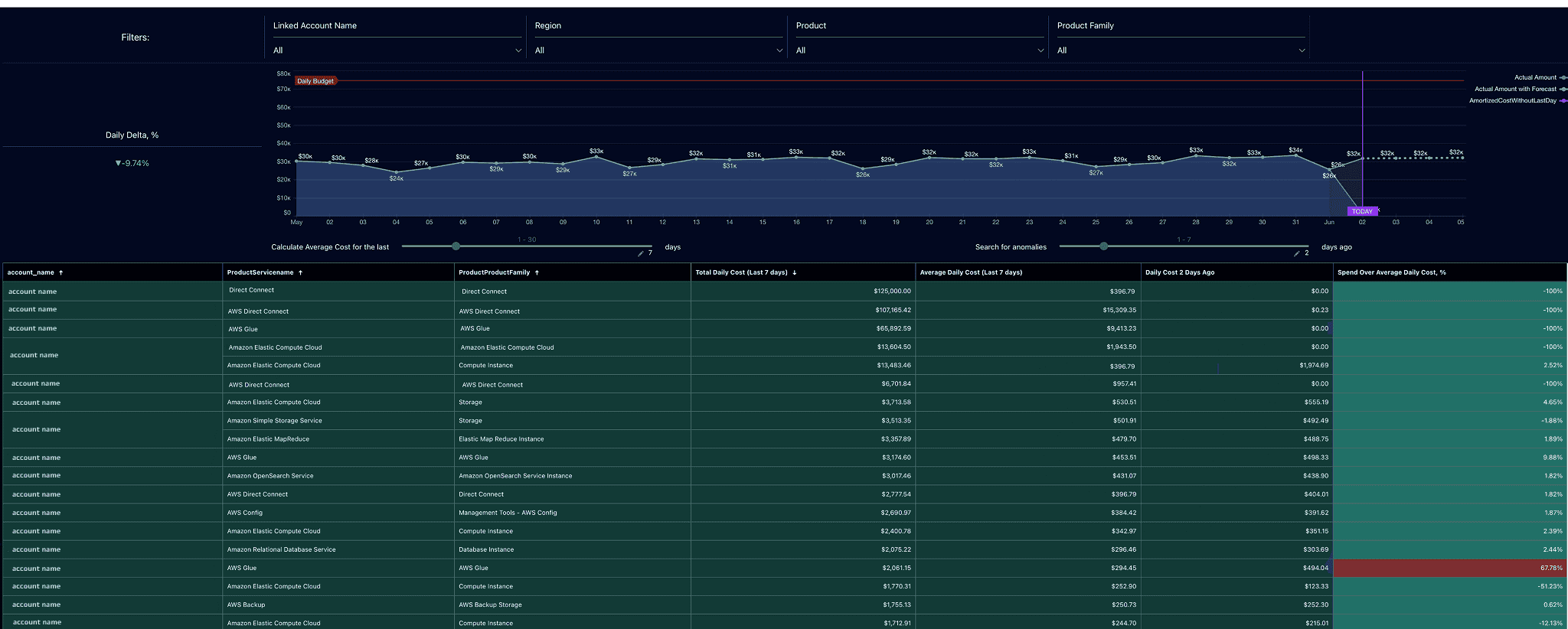
Element of the Cloudaware FinOps dashboard. See it in action on a live demo. - You can filter by blended, unblended, amortized, or list rate — no guessing what finance is looking at.
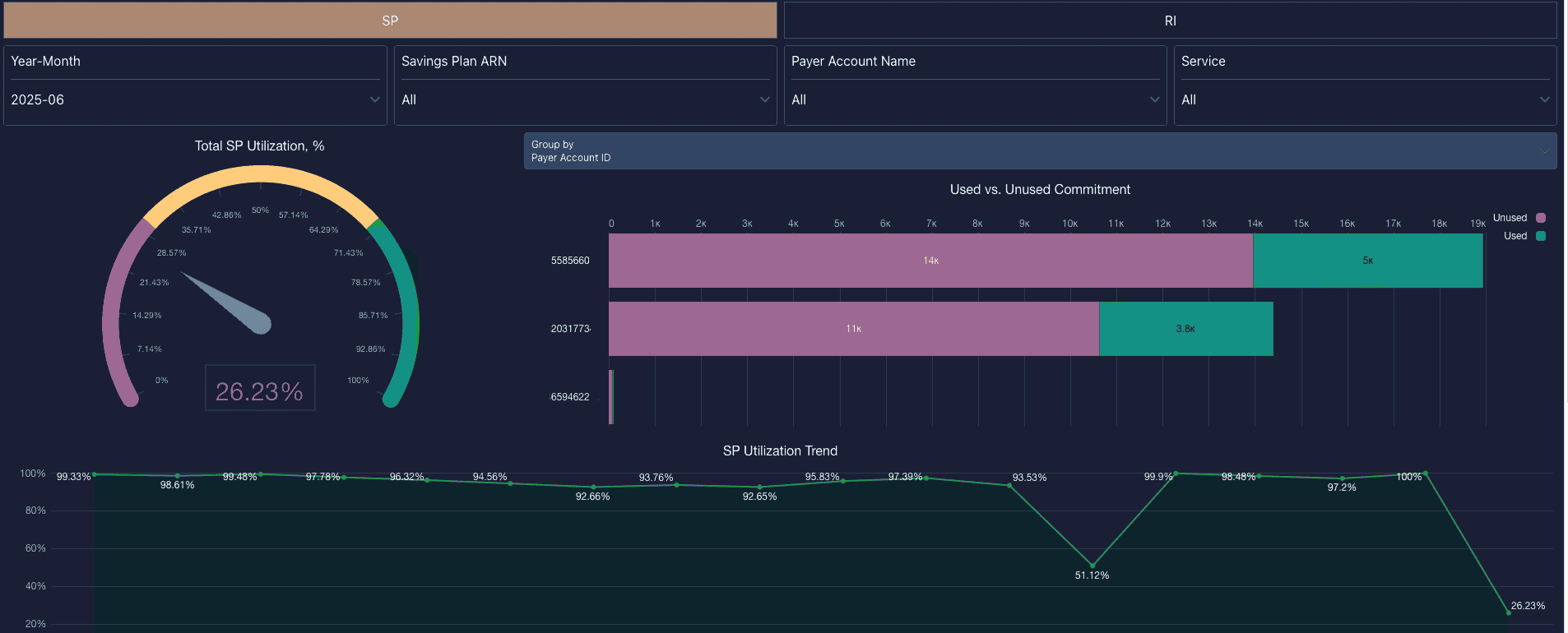
Element of the Cloudaware FinOps dashboard. See it in action on a live demo. - Missed tags? Cloudaware’s dashboards don’t just drop them — they flag them.
- Every widget, filter, and view is FinOps-aware: showback, allocation, anomaly outliers, and trending over time — all exportable, all automatable.
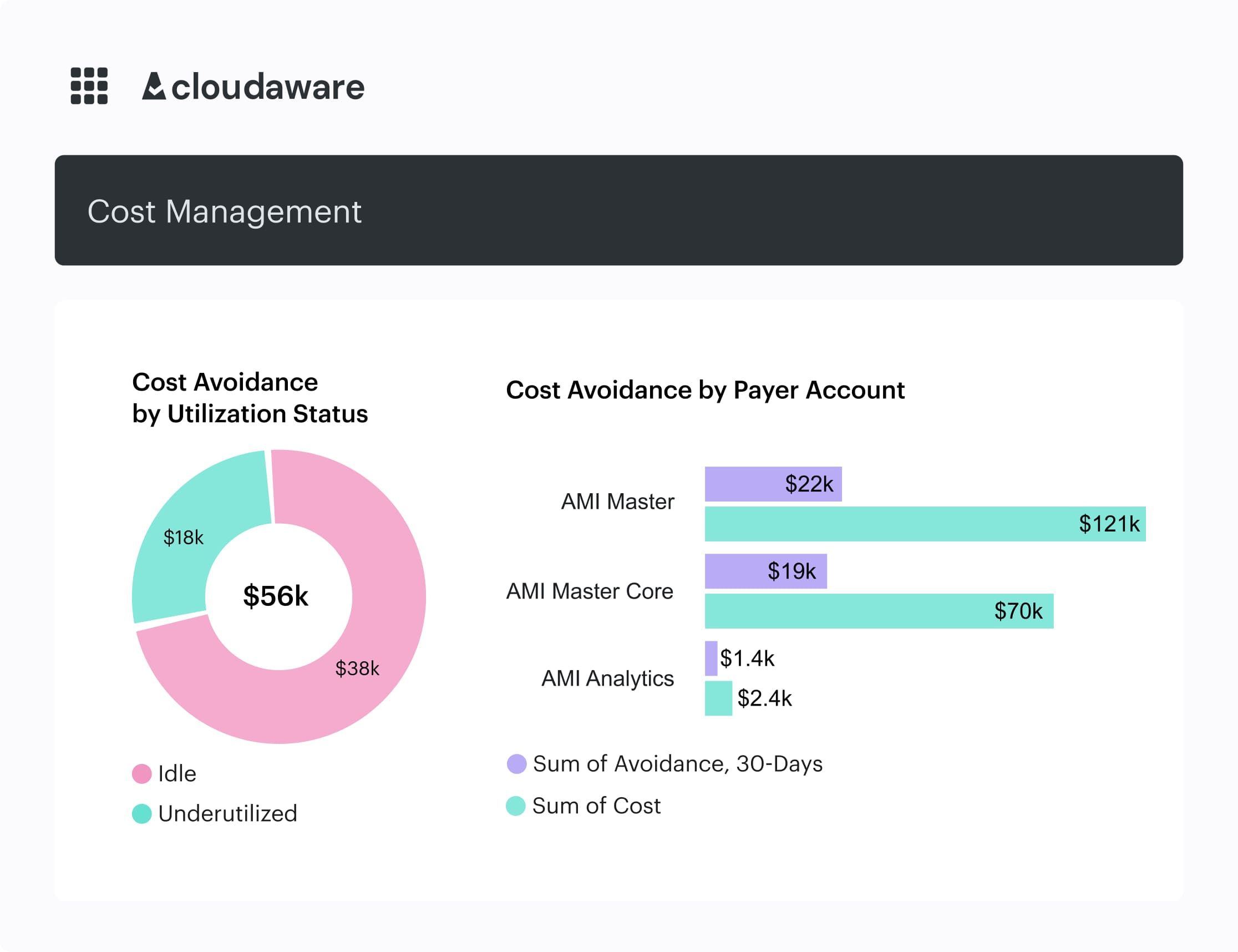
Element of the Cloudaware FinOps dashboard. See it in action on a live demo.
And yeah, it’s not just a read-only layer. You can build alerts, rules, and workflows inside the platform to keep your cloud cost processes aligned.
CloudZero – visibility through business lenses
CloudZero flips the script. Instead of cost per resource, it helps you understand cost per feature, team, customer, or deploy. It doesn’t wait for perfect tagging — it builds logic around the dimensions you care about.
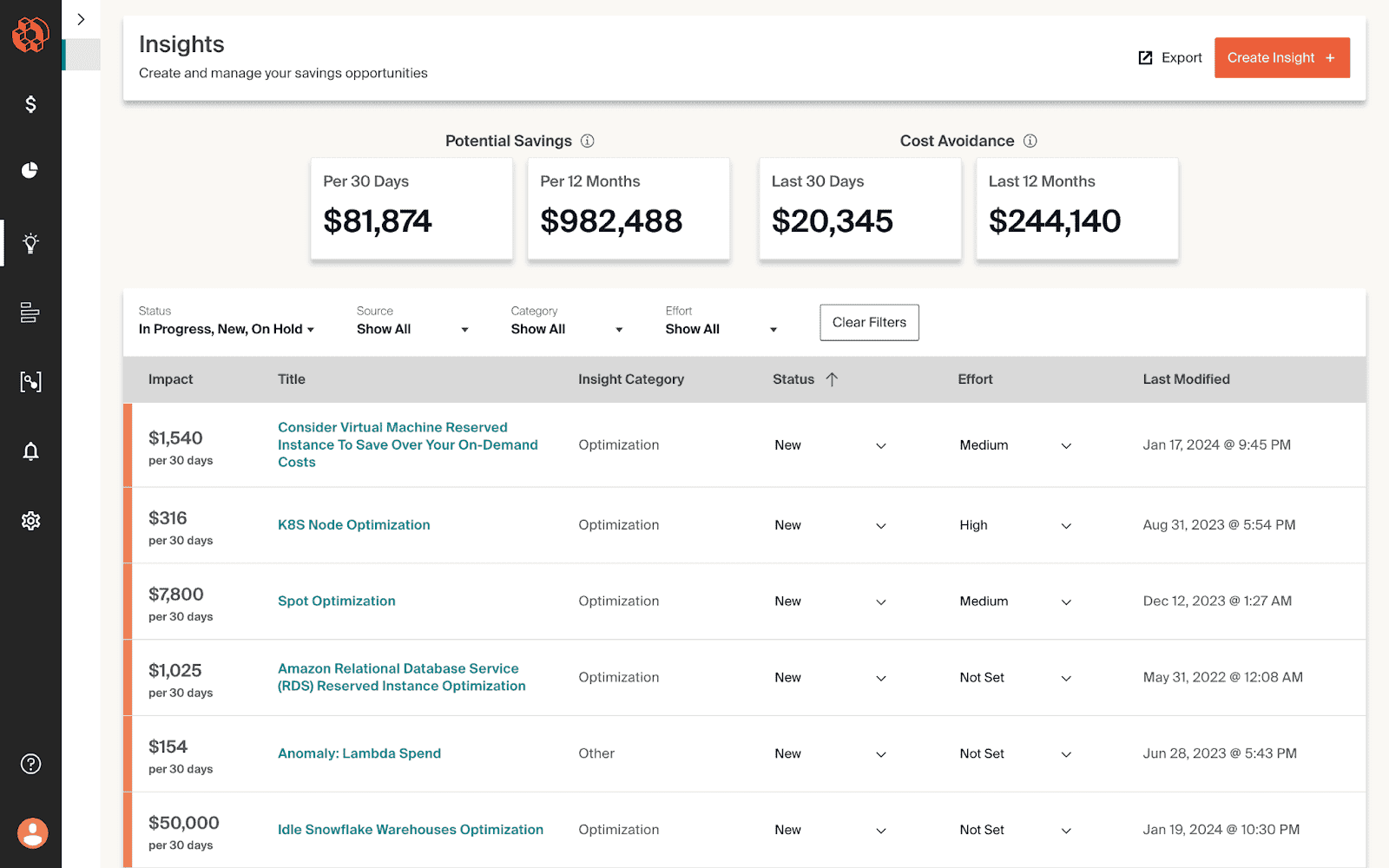
Image source.
How it gets visibility right:
- CloudZero Dimensions lets you define custom contexts — like “Feature Alpha in prod” or “Spend by Team Bravo.”
- Their Explorer tool lets engineers trace spend anomalies down to individual services.
- Hourly anomaly detection means FinOps sees weird cost spikes as they happen.
- You can track cost trends per sprint, per service, per anything — without needing a clean tagging baseline.
This is a dream when you’re trying to link costs back to engineering effort or product value.
| Feature | Cloudaware | CloudZero |
|---|---|---|
| Multi-cloud billing visibility | ✅ Native support for AWS CUR, Azure EA, and GCP billing | ✅ AWS, Azure, and GCP cost data ingest supported |
| Daily spend breakdown | ✅ Daily updated views with project/team filters | 🟡 Available, but focus is more on trends and anomalies |
| Rate types supported | ✅ Blended, unblended, amortized, list — fully selectable | 🟡 Typically shows unblended/spend totals |
| Custom dimensions for cost grouping | ✅ Tag-based filters, custom dashboards and custom by feature, team, etc. | ✅ CloudZero Dimensions (feature, team, customer, etc.) |
| Tag hygiene handling | ✅ Flags missing/untagged resources clearly, fixes tags inconsistencies | ✅ Works around missing tags via dimensions logic |
| Anomaly detection | ✅ Real-time via spend reports or dashboard rules | ✅ Hourly, real-time anomaly detection |
| Engineer-friendly views | ✅ More reporting-oriented and customizable | ✅ Explorer tool gives detailed service-level visibility |
| Workflow automation | ✅ Built-in via Force.com (alerts, thresholds, reports) | 🟡 External systems or integrations recommended |
- With Cloudaware, you feel in control. You’ve got consistent data, clean views, and the power to layer FinOps workflows on top of it.
- With CloudZero, you feel insightful. You get a business-aligned, context-first view of costs — even when tagging is messy or incomplete.
They’re solving the same visibility challenge, just from different angles.
So if your finance lead is still asking “why did storage double last month,” or your engineering team swears it wasn’t their Lambda, this is the moment. Visibility is the first win in FinOps — and both platforms help you grab it.
Allocation & Tagging
This is the part where every dollar in your cloud bill should be traceable — to a team, a product, a cost center, or a feature. In theory? Sounds simple. In practice? It's a battlefield.
Tags are often inconsistent, half-missing, or creatively named by teams who’ve never met each other. One service uses Owner, another uses Team, and someone decided Stage=Sandbox counts as prod. Then there’s the stuff no one tagged at all — like the EC2 instance running for months under a test account.
Meanwhile, your finance lead is asking for showback reports per business unit, your platform team needs to split shared services spend, and your dashboards are 20% blank because no one filled in the Environment field.
That’s the chaos Cloudaware and CloudZero are built to tame — just in two very different ways.
Cloudaware
Cloudaware doesn’t just read your tags — it audits them, slices them, cross-checks them against your organizational metadata, and highlights what’s missing. It's like having a FinOps operations surgeon on your team.
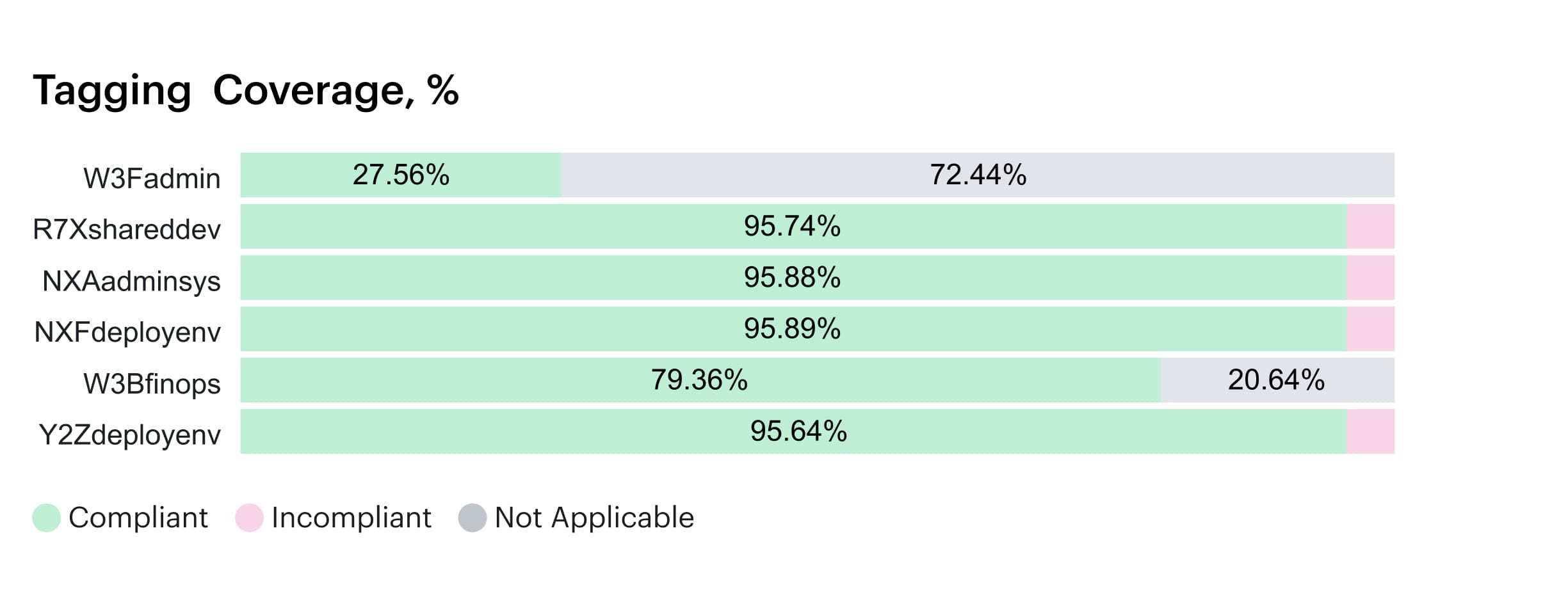
Element of the Cloudaware tagging dashboard. See it in action on a live demo.
Here’s what makes it powerful:
- Daily cost ingestion from AWS CUR, Azure EA, and GCP, with line-item precision.
- Tag completeness tracking: You’ll instantly see what’s missing, malformed, or outdated — across thousands of line items.
- Allocation rules engine: You can allocate spend by tag, account, service, project, or any custom field you define in Salesforce or the Cloudaware CMDB.
- Multi-dimensional allocation views: Filter costs by combinations like Environment:Prod + Team:Data + Application:Kafka-Ingest. It just works.
- Fallback rules for untagged items: Don’t lose sleep over unused resources — Cloudaware routes them to default owners, cost centers, or flags for review.
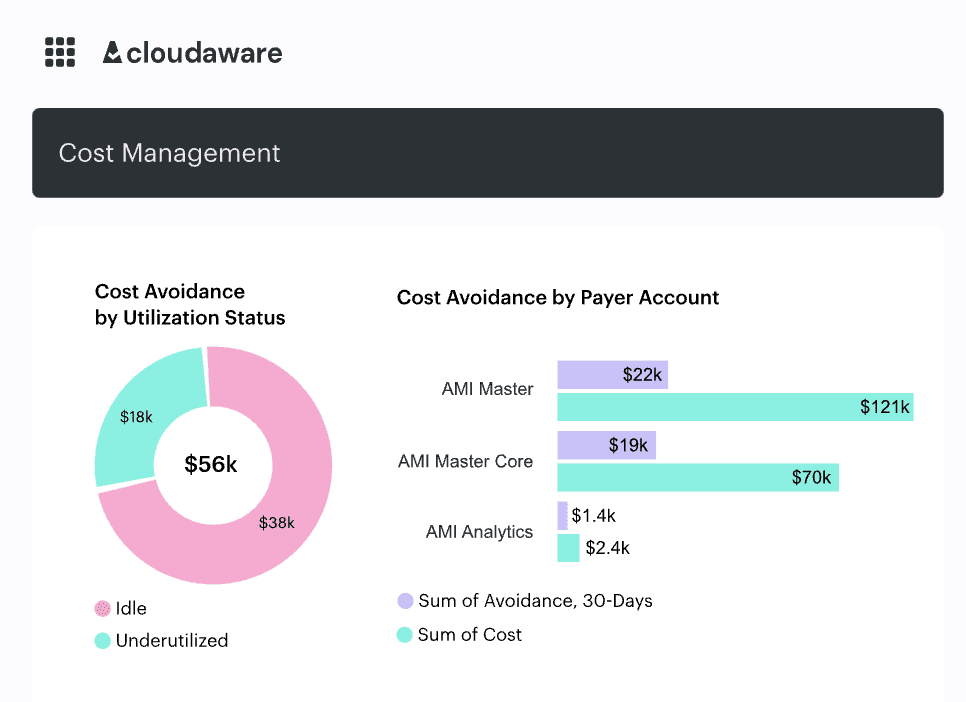
Element of the Cloudaware FinOps dashboard. See it in action on a live demo.
You get a system where every dollar has a tag, an owner, and a trail, even if you didn’t get your tagging perfect upfront.
CloudZero’s approach?
Tell us what business context matters, and we’ll show you how your costs align. It doesn’t lean on tags — it builds its own data model with what they call Dimensions.
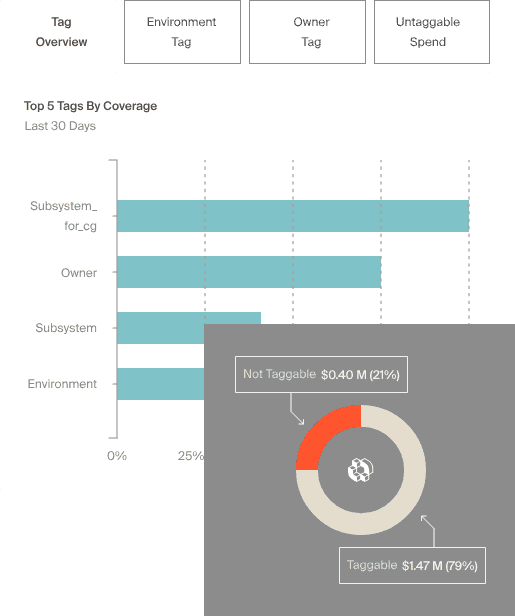
Image source.
Here’s how it helps teams win:
- No tag dependency: Define logical rules like “all spend from Account A + Service B = Product Team C,” even if the resources aren’t tagged that way.
- CloudZero Dimensions let you create custom lenses for allocating spend by team, customer, product, environment, or deployment cycle.
- Dynamic allocation: Changes to org structure or team ownership? Just update the Dimension logic — no need to re-tag infra.
- Tag visibility is still there, of course — but it's not the foundation, it’s just one data point.
- Engineers get cost feedback loops in context of what they shipped — so tagging becomes an operational habit, not a finance mandate.
With CloudZero, you’re not just allocating spend — you’re telling the story of how cloud costs connect to product delivery, in the terms your teams actually use.
| Feature | Cloudaware | CloudZero |
|---|---|---|
| Tag hygiene audit | ✅ Full visibility with error detection | 🟡 Partial, used as supplemental signal |
| Allocation by custom logic | ✅ Tags, accounts, metadata | ✅ Dimensions (tagless or tag-supported) |
| Dynamic fallback rules | ✅ Route untagged spend | 🟡 Requires logic setup per case |
| Business-context mapping | ✅ With tagging, dimensions, and custom fields | ✅ Natively supported with Dimensions |
| Multi-cloud cost alignment | ✅ Daily normalization | ✅ Real-time alignment with context |
When allocation breaks down, FinOps turns into guesswork — and trust me, nobody wants to defend that spend spike in a QBR with “we think it’s R&D... maybe.”
Both platforms step up to the plate. Cloudaware gives you the surgical tools to make tagging and allocation exact. CloudZero gives you a narrative lens to make it meaningful — even if your tags are duct-taped together.
Cost Optimization: rightsizing, idle detection, and alerts
Here’s the task we’re solving: making cloud costs efficient, accountable, and under control — before they balloon. That means identifying resources you’re overpaying for (hello, over-provisioned compute), catching idle services before they silently drain budgets, and setting up alerts that fire at the right time — not three days after finance flags the bill.
Rightsizing is about adjusting capacity to fit actual usage — think EC2s or containers running at 10% utilization for weeks.
Idle detection is about surfacing stuff no one’s using — volumes, snapshots, zombie databases just... existing.
And alerts? Those are your early-warning system when spend spikes, thresholds break, or something drifts out of compliance.
FinOps teams, DevOps leads, and cloud architects need tools that don’t just show the problem, but actually help teams act on it — fast, at scale, and across clouds.
Let’s see how Cloudaware and CloudZero help you do exactly that.
Cloudaware
Cloudaware is like having a no-BS FinOps analyst in your corner, armed with x-ray vision and a rulebook.
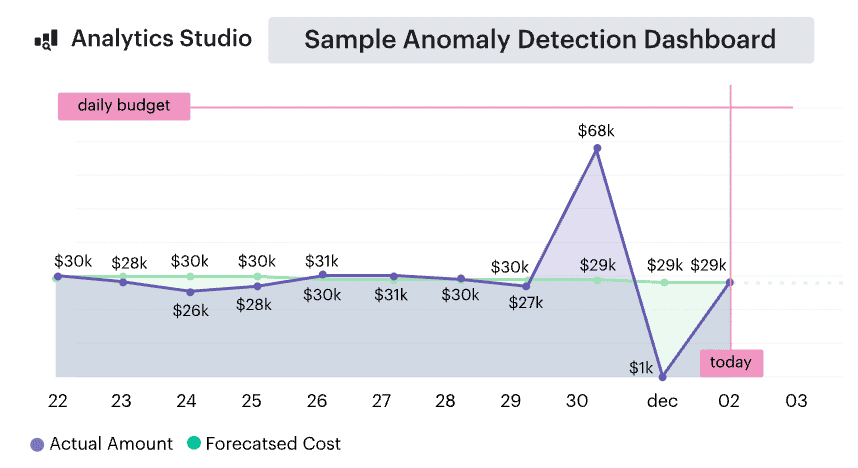
Part of the cloud forecast and anomaly detection dashboard. See it in action on a live demo.
What it actually does:
- ✅ Idle Detection. Define policies like “unattached EBS > 7 days” or “low-util EC2s under 5% CPU” → flagged, logged, and routed for cleanup.
→ Seen teams save $10K+ monthly just by setting EBS rules. - ✅ Rightsizing Insights. Daily views show over-provisioned compute across AWS, Azure, GCP. It won’t just nudge you — it tells you what’s wrong and how to fix it.
- ✅ Custom Alerting Workflows. Built into Force.com. Set alerts for when cost thresholds are hit, tag violations occur, or idle policies trip.
→ Perfect for teams with cost guardrails tied to compliance. - ✅ Integration with cost allocation + CMDB. Optimization tasks are always linked to business units or service owners — so no orphan alerts.
Best for you if: You’ve got well-defined cost policies, compliance needs, and want to automate FinOps workflows from the center.
CloudZero
CloudZero thinks in velocity. It doesn’t just highlight idle resources — it makes them relevant to the people who deployed them.
How it helps optimize in real time:
- ✅ Rightsizing Recommendations via CloudZero Advisor. Highlights over-provisioned K8s, EC2, storage, and Lambda services — complete with context like feature owner or deployment source.
- ✅ Idle Detection (Tagless Ready). Surfaces idle compute even when tagging’s sloppy, using account/service/resource logic built with Dimensions.
- ✅ Real-Time Anomaly Alerts. AI flags cost spikes within the hour. No waiting for your monthly report to catch a runaway instance.
→ Delivered via Slack, email, or webhook — right to the DevOps or FinOps team who owns it. - ✅ Embedded in Dev Workflows. Cost signals are tied to sprints, releases, environments, or features — whatever lens your team actually uses.
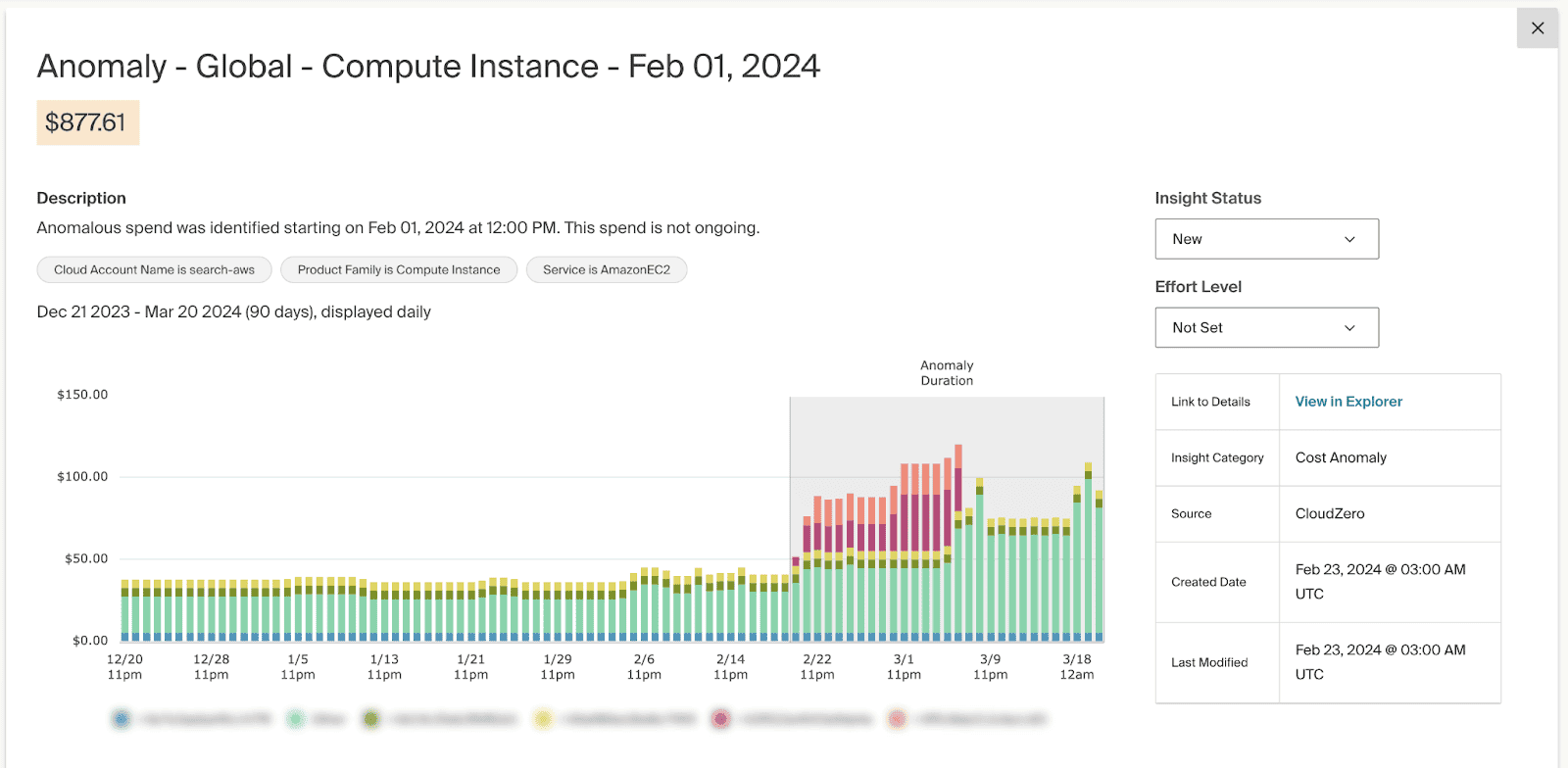
Anomaly detection report at CloudZero. Image source.
Best for you if: You want live, dev-friendly cost insights that fit into engineering cycles and don’t rely on perfect tagging.
| Task | Cloudaware | CloudZero |
|---|---|---|
| Idle Detection | Policy-based (e.g. EBS > 7d, EC2 < 5% CPU) | Automatic, even without tags |
| Rightsizing | Dashboard + rules-based identification | CloudZero Advisor + real-time context |
| Alerts & Notifications | Rule-based via Force.com | Hourly AI-based anomalies via Slack/Email/Webhooks |
| Actionability | Tied to allocation rules + CMDB | Tied to Dimensions (e.g. Feature, Team, Env) |
| Workflow Integration | Salesforce-native automation | Embedded in DevOps workflows, sprint cycles |
- Choose Cloudaware if you need structured control, governance-aligned alerts, and deep tagging logic that integrates with your internal cost allocation systems.
- Choose CloudZero if you want cost signals embedded into engineering workflows and real-time feedback that speaks Dev.
Forecasting & Budget Management
We’ve all been there: you set a nice clean budget, the quarter starts off strong, and then suddenly some team forgets to shut down a staging cluster and… bam, you’re over budget and explaining it to finance like it was an act of God.
So here’s the real task: You need to forecast spend based on actual usage patterns, track budgets in real time, and alert the right people before anything gets out of hand. Not after. Not “Oops.” Before.
Now let’s look at how Cloudaware and CloudZero help you do that — each in their own flavor.
Cloudaware
Cloudaware is for the ops-driven brain — you know, the kind that likes organized dashboards, defined budgets, and rules that actually work. It pulls in your cloud billing data (AWS, Azure, GCP) and overlays it with your tags, CMDB, and project ownerships.
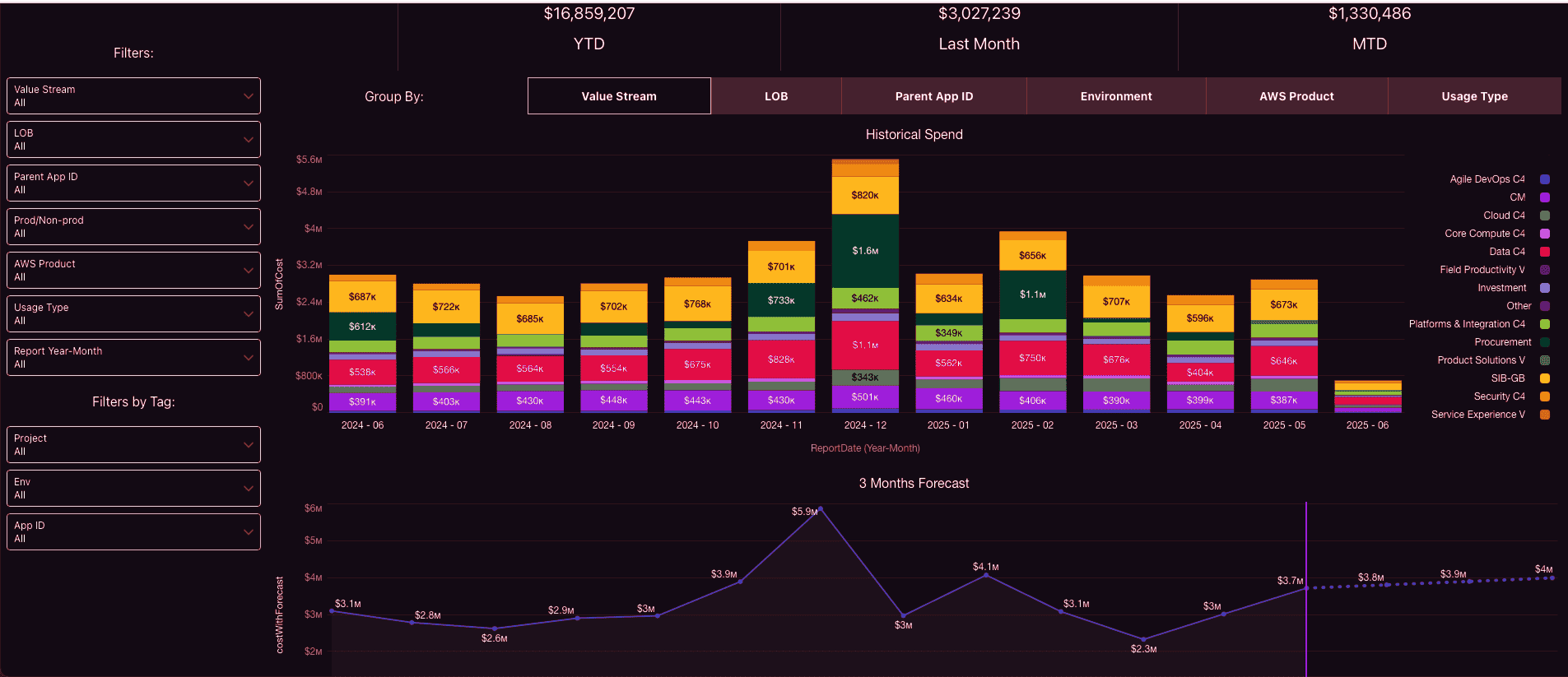
An element of the forecasting dashboard at Cloudaware. See it in action on a live demo.
Here’s what it brings to the budgeting table:
- 🔮 Live Forecasting – Daily auto-updated projections by tag, account, service, or team. No spreadsheets, no guessing.
- 🚨 Threshold Alerts – Set a cap? Cloudaware pings you when you’re trending toward it. Your budget’s safety net.
- 📊 Dashboards Built for Reporting – Slice by cloud, business unit, or environment. Perfect for finance, perfect for exec decks.
- 🔄 Workflow Automation – Breach a budget? It can auto-generate a ticket, notify the app owner, and escalate if needed.
CloudZero
Now if Cloudaware is the spreadsheet brain, CloudZero is the product brain. It tracks spend in ways your engineering teams actually understand — by feature, team, customer, or sprint. They call this magic “Dimensions.”
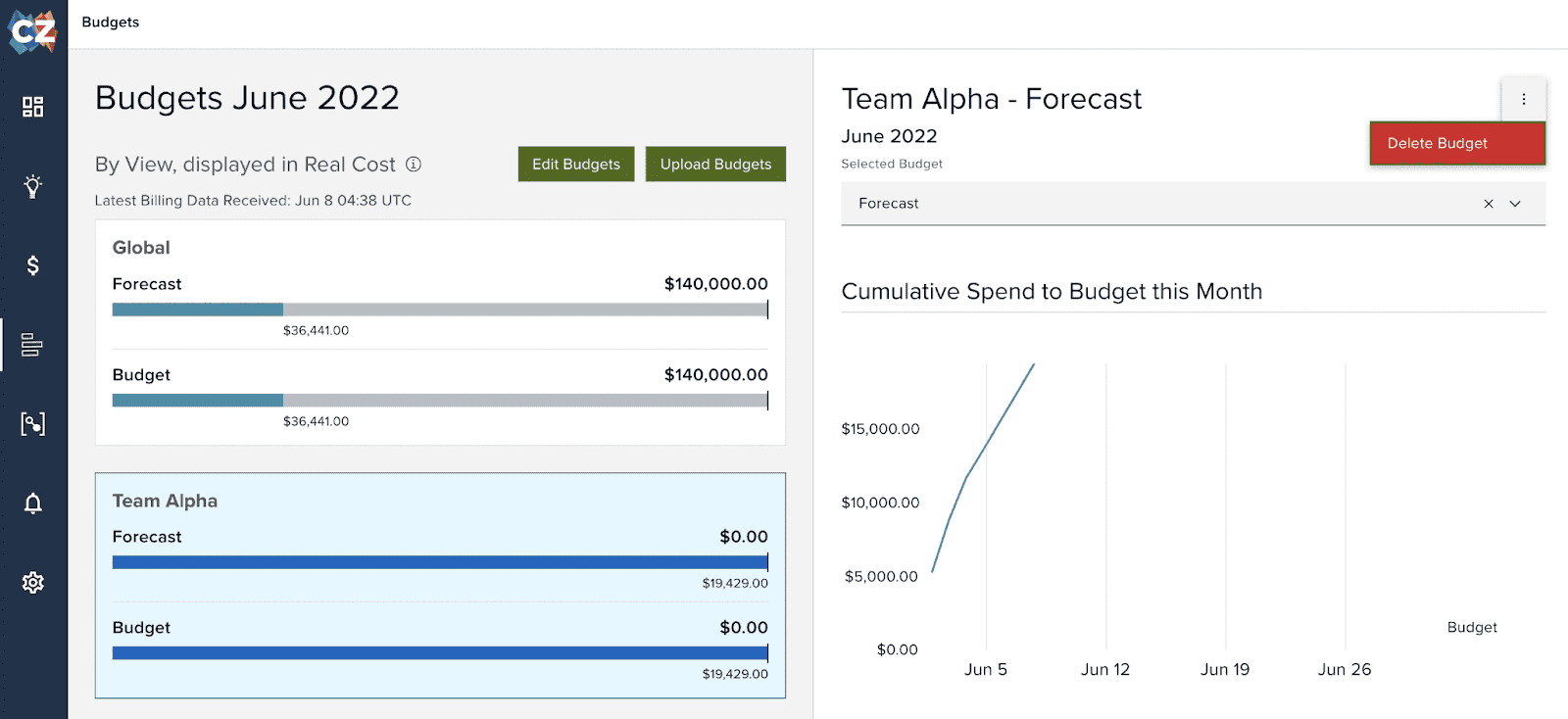
Budget forecasting at CloudZero. Image source.
Here’s what it does really well:
- Dimensions-Based Budgets – Set budgets by feature or team (no clean tags required) and get real-time burn updates.
- Forecasting with Context – CloudZero shows if your spend is trending over and why. Like, “Team Delta’s storage just spiked after that deploy.”
- Proactive Alerts – Hourly variance alerts delivered via Slack or email, with links to the exact workload or service causing it.
- Custom Views for Everyone – Finance gets clarity. Engineers get real insight. No one’s in the dark.
What It Feels Like
| Feature | Cloudaware | CloudZero |
|---|---|---|
| Budget logic | Tags + CMDB fields | Dimensions (team, feature, product) |
| Forecasting | Daily trends from billing data | Real-time burn with predictive signals |
| Alerts | Triggered via internal workflows | Delivered to team comms (Slack/email) |
| Who it helps | Finance, governance, IT leads | Engineering, product, FinOps |
| Setup vibe | Structured, rule-based | Agile, flexible, fast-moving |
What fits you?
Go Cloudaware if:
- You already track cloud costs by tag, account, or business unit.
- You want budget alerts integrated with internal approvals or ticketing.
- You’re managing formal budgets across cost centers and environments.
Go CloudZero if:
- Your teams think in features, not billing accounts.
- You want real-time insights that show who, what, and why a budget is drifting.
- You need budgets that DevOps and Product folks will actually use.
Collaboration across teams
Budgets are slipping, anomalies are popping off like popcorn, and no one’s sure who owns that mystery GCP charge from last Tuesday. We’ve all been there.
This part of FinOps? It’s about building a cross-team rhythm — where DevOps, Product, and Finance all get the same signals and actually act on them together.
The goal:
- Show the right info to the right people
- Route cost spikes before they become finance escalations
- Make sure every engineer, PM, or ops lead knows what they own — and what it’s costing
Here’s how Cloudaware and CloudZero make that happen.
Cloudaware – cost collaboration that’s buttoned up and built in
If your org is already knee-deep in Jira workflows, SLAs, and weekly reporting rituals, Cloudaware just slides right in like it was always meant to be there.
What makes it click:
- Tight integrations with Jira, PagerDuty, ServiceNow — cost alerts don’t float in space, they become action items right inside your ops tools.
- Custom dashboards with role-based access — Finance sees budgets, DevOps sees infra, SREs see what's failing.
- Force.com automation — breach a budget? Boom. Ticket’s made. Approver’s tagged. Someone’s fixing it.
- Structured insights that tie back to your CMDB, so no more “who owns this?” debates.
A friend set up workflows so that every budget anomaly got routed into Jira. No more “who’s on it?” — just resolution, fast. Unowned cost noise? Down 60%. The CFO was thrilled. The DevOps lead stopped hiding.
CloudZero – team collaboration that moves at dev speed
CloudZero’s vibe? It turns cloud spend into a shared Slack conversation. Engineers, PMs, FinOps — everyone’s working off the same cost narrative, in language that actually makes sense to them.
What makes it shine:
- Real-time Slack or email alerts — you’ll know the what, who, and why behind a spend spike before the monthly finance deck even renders.
- Dimensions dashboards — you can group costs by team, feature, customer, release cycle… whatever fits how your org actually works.
- FinOps Account Manager — yes, a real human who helps you align reporting, alerts, and reviews across teams (think: built-in FinOps buddy.)
- Ready-to-use reports — cross-team playbooks, sprint cost breakdowns, and exec summaries… you won’t be stuck building these from scratch.
What It feels like for real people
| Role | Cloudaware Feels Like… | CloudZero Feels Like… |
|---|---|---|
| Finance Lead | Finally getting cost data you can trust — plus escalation flows that work | Seeing which team or feature caused a spike and knowing someone’s already on it |
| DevOps Engineer | Structured workflows and alerts landing in your queue | Slack alerts with context, tied to the services you just deployed |
| Cloud Architect | Infra usage and cost linked back to actual owners | Seeing spend from your last sprint show up in real time |
| Product Manager | Visibility via reports and workflows | Budget vs. actual for your features — clear and in your face (in a good way) |
The Friend-to-Friend Decision Table
| Feature/Need | Cloudaware | CloudZero |
|---|---|---|
| Cost alerts into workflows | ✅ Native to Jira, PagerDuty, ServiceNow | ✅ Slack, email, webhook — real-time |
| Role-specific dashboards | ✅ CMDB + permission-based | ✅ Dimensions per team, product, etc. |
| Structured escalation | ✅ Force.com automations | 🟡 Alert-driven, informal (but fast) |
| Embedded FinOps help | ✅ Dedicated FinOps Account Manager | ✅ Dedicated FinOps Account Manager |
| Setup effort | Medium–High (tag + CMDB power) | Medium (set Dimensions + alert routing) |
| Best for orgs that… | Run on governance, workflows, and clear cost centers | Want speed, agility, and dev-friendly visibility |
- If your org thrives on structure, workflows, and defined ownership, Cloudaware is your governance soulmate.
- If your teams move fast and you want cost data to ride shotgun in Slack or sprint retros, CloudZero is your FinOps spirit guide.
Either way? You’re building a cost-aware culture — and that’s a win.
FinOps reporting & analytics
Reporting alone won’t cut it anymore. What your org really needs is analytics that connect the dots between raw cloud costs and smart business decisions — daily, across teams, and without a 40-tab spreadsheet.
This task is all about:
- Turning cloud billing data into real-time, multi-dimensional insight
- Giving every team — from Finance to Engineering — a view they understand and act on
- Surfacing anomalies, inefficiencies, and trends — automatically
- Making sure no one’s left asking, “Where did that $40K go?”
Let’s break down how Cloudaware and CloudZero tackle this with features your FinOps processes will actually lean on.
Cloudaware
Cloudaware isn’t just a reporting engine — it’s your central intelligence layer for FinOps and ITAM. With deep CMDB integration, Salesforce-native analytics, and real-time usage visibility, it gives your teams the power to turn cloud spend into action.
What you get:
✅ Analytics Studio. Dynamic, interactive dashboards that let you slice and dice usage and cost data across accounts, services, teams, regions — and tie everything back to your CMDB.
✅ Usage Analytics. Prebuilt dashboards that highlight idle resource trends, RI/SP underutilization, and high-variance workloads — customizable by cloud, service, or tagUsage Analytics - FAQ.
✅ Force.com Reporting Engine. Build complex custom reports with cost formulas, CMDB fields, tags, account metadata, and even custom SLAs. Perfect for chargeback, showback, and budget forecasting.
✅ ITAM-Specific Dashboards. Need visibility into asset lifecycle costs, license utilization, or cost-per-asset group? Use CMDB relationships to create reports for:
- Hardware/software cost by status or location
- Depreciation tracking linked to spend
- Non-compliant or orphaned asset cost mapping
- Application spend grouped by criticality or ownership
✅ Persona-Specific Views. Finance gets cost center rollups. DevOps sees infra-level inefficiencies. Asset managers get lifecycle cost analysis — all from the same system.
✅ Dashboard Concierge. Cloudaware will build complex reports and dashboards for you — yes, including ITAM views — at no additional cost.
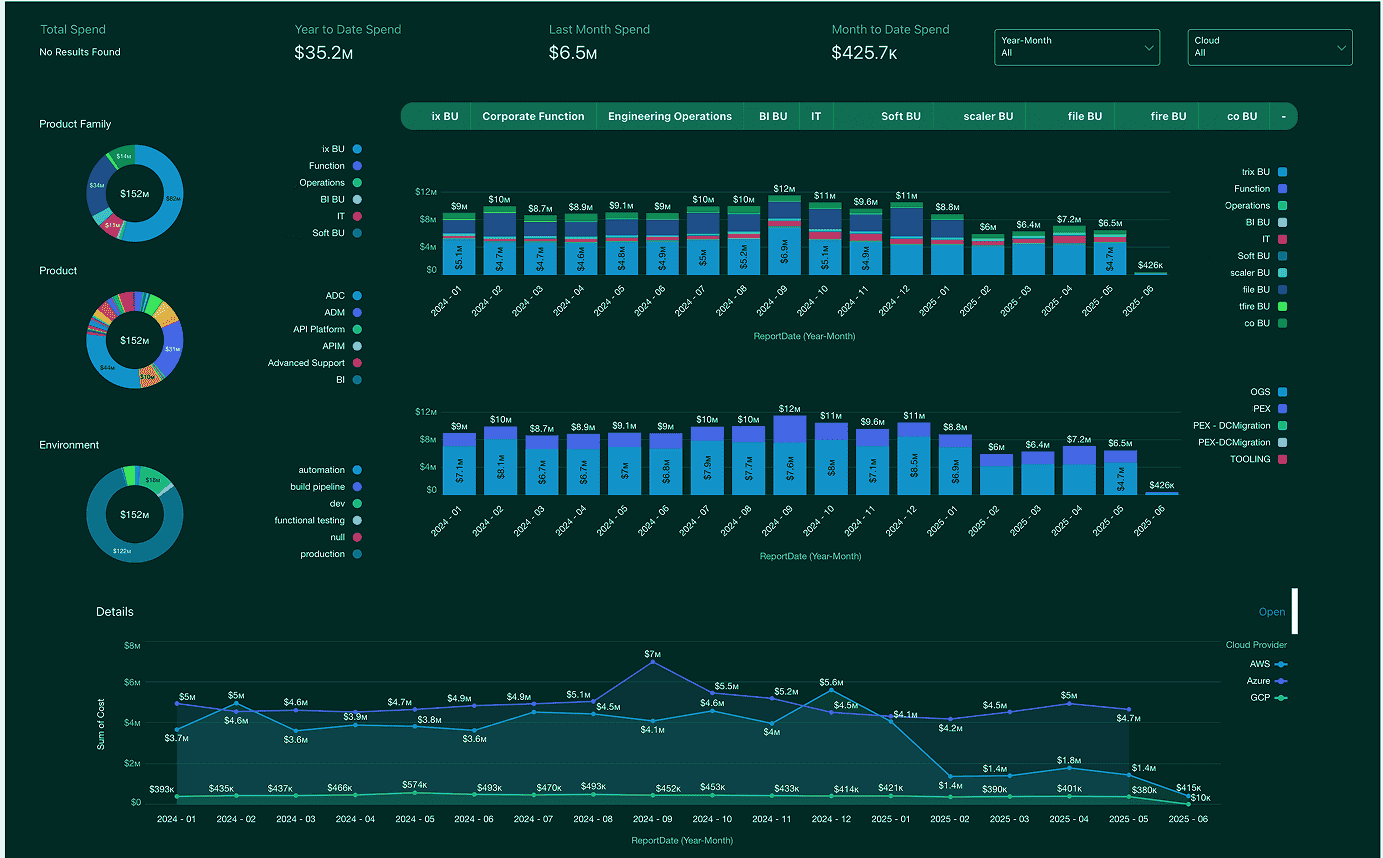
Example of the FinOps dashboard at Cloudaware. See it in action on a live demo.
One enterprise team used Cloudaware to build a report showing all infrastructure spend tied to assets past their lifecycle renewal date. Result? They shut down $12K/month in ghost workloads in two weeks flat.
CloudZero
CloudZero is purpose-built to turn cost signals into business intelligence. Think of it as a real-time radar for your cloud finances — one that speaks feature, sprint, team, or deploy.
What you get:
- Prebuilt Dashboards. Cost per Feature, Budget vs. Actual, Anomaly History, Unit Cost (e.g. cost per API call, session, or customer) — ready from day one.
- Dimensions-Powered Analytics. Map spend to business logic — features, customers, deploys, releases — without needing clean tags. Great for fast-moving teams.
- AnyCost™ Ingest. Pull in cost data from AWS, Azure, GCP, Kubernetes, Datadog, Snowflake, MongoDB, OpenAI, Databricks, and more — into a unified viewAny Cloud Cost Source, ….
- Alert + Export Automation. Send insights directly to Slack, email, dashboards, or Tableau via webhook/API. Share cost anomalies or forecast risks with just a click.
- Real-Time Unit Economics. Track cost per user, per transaction, per deployment. Use this to tie infrastructure spend to product performance.
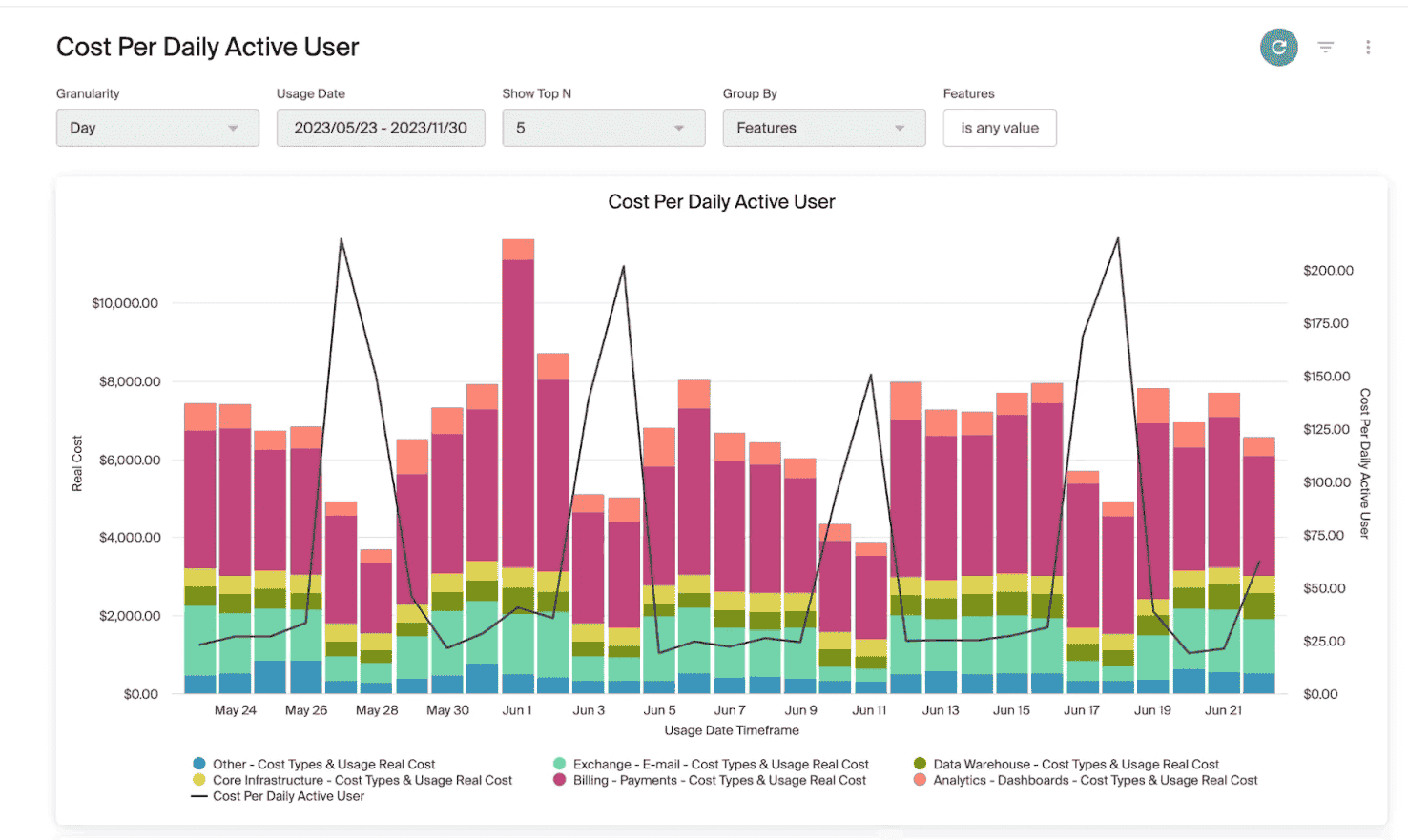
Example of the Cost analytics dashboard at CloudZero. Image source.
👥 Who gets what value
| Role | Cloudaware | CloudZero |
|---|---|---|
| Finance | Detailed, customizable cost reporting by BU, SLA, or cost center | Live budget vs. actual, team-specific dashboards |
| DevOps | Real-time usage + idle trends, rightsizing, anomaly tracking | Slack alerts, cost-per-service visuals, real-time variance tracking |
| Architect | Multi-cloud CMDB views, tag audits, infra alignment | Deployment-linked insights, workload vs. cost analysis |
| Product | Cost-to-feature dashboards via Studio or Concierge | Cost per feature/sprint, with no manual tagging work |
Buyer’s fit guide
| Factor | Cloudaware | CloudZero |
|---|---|---|
| Setup Time | 4–6 weeks (with tag + CMDB mapping) | 1–2 weeks (set Dimensions, connect sources) |
| Customization Power | Enterprise-grade (Force.com + Analytics Studio) | Medium-high via Dimensions + AnyCost |
| Time to Insight | Moderate ramp, deeply customizable | Fast time-to-value with prebuilt reports |
| Export Options | Excel, CSV, PDF, PNG, Dashboard snapshots | PDF, CSV, PNG, API, Slack, Webhook |
| Best For | Structured orgs, audit-heavy teams, SLA visibility | Agile teams, product orgs, fast decision loops |
TL;DR
- Cloudaware is your FinOps engine if you need structured, CMDB-enriched reporting, want multi-cloud analytics built for governance, and love having a support team that builds dashboards for you.
- CloudZero is your go-to if you need fast, business-aligned insights, want to track costs across features or users, and need analytics your product teams will actually look at.
Integrations
You know that feeling when you’ve got cost data from AWS, Azure, GCP, maybe even Kubernetes and Snowflake, all humming… until someone tries to pull in OpenAI usage or reconcile the invoice from Databricks? Welcome to the jungle that is FinOps integrations.
This task is about automating cost ingest and enrichment across IaaS, PaaS, and SaaS — without duct tape scripts or manual tagging gymnastics.
What matters most:
- Native support for your cloud providers and services
- Enrichment with business logic (CMDBs, tagging, team mapping)
- Real-time sync with ticketing, alerting, and reporting tools
- APIs and webhooks that actually work (and don’t need babysitting)
Let’s talk shop — Cloudaware and CloudZero each have their own vibe here.
Cloudaware
If your team lives in Jira, ServiceNow, or Salesforce, Cloudaware is your plug-and-play control tower. This platform isn’t just API-rich — it’s integration native.
Key features:
- Native billing integrations with 60+ tools like AWS, Azure, GCP, including support for linked accounts and AWS Organizations setups AWS Billing.
- Jira, ServiceNow, and PagerDuty integrations that route anomalies and budget breaches straight into workflowsOther Integrations.
- Force.com backbone lets you extend logic via Apex classes, triggers, and automated actions.
- CMDB-backed enrichment for aligning cost data with owners, environments, and SLAs
- Webhook + API support to sync into ITSM tools or external reporting systems.
CloudZero
CloudZero’s secret weapon is its AnyCost™ engine — designed to ingest any cost data, from infra to AI usage, without needing perfect tags or billing formats.
Key features:
- Direct integrations with AWS, Azure, GCP, Kubernetes, Snowflake, Datadog, MongoDB, Databricks, OpenAI, and moreAny Cloud Cost Source, …
- API and webhook support to push insights into Slack, Jira, or your BI stack.
- No-tag-required ingest with “Dimensions” to organize by team, customer, feature — even if tags are a mess.
- Flexible unit cost tracking, meaning you can see cost per request, deployment, or user session — whatever maps to business outcomes.
Side-by-side snapshot
| Integration Area | Cloudaware | CloudZero |
|---|---|---|
| Cloud Billing Sources | AWS, Azure, GCP (via CUR, APIs) | AWS, Azure, GCP + Kubernetes, Snowflake, OpenAI, Databricks, more |
| ITSM Tools | Jira, ServiceNow, PagerDuty native support | Slack, Jira (via webhook/API) |
| Data Enrichment | CMDB-driven, tag-based | Dimensions, metadata injection |
| Custom Logic/Rules | Apex, Force.com workflows | API + webhook automation |
| Best for Teams Who… | Need structured escalation + asset ownership clarity | Want rapid integration of any spend source with flexible grouping |
- If you’re running tight ITSM processes and care about full traceability from asset to alert, Cloudaware gives you the wiring to do it all.
- If your team needs to move fast, pull in costs from everywhere, and organize spend by what matters most, CloudZero’s integrations are like a universal adapter for your FinOps brain.
Price
Cloudaware
Cloudaware doesn’t do cookie-cutter pricing. Instead, it offers a modular structure that starts with its core product — the CMDB. Why? Because in Cloudaware’s world, there’s no FinOps without full visibility into your infrastructure. The CMDB maps every server, service, and tag in your environment, making cost analysis meaningful.
Here’s how the pricing breaks down:
- First, you buy the CMDB module, which is priced based on the number of configuration items (CIs). For most environments, this averages out to about $0.008 per CI per month.
- For a setup with 100 cloud servers, you're looking at around $400/month for CMDB.
- Then, if you want cost management features, you add the FinOps module, which is priced at 20% of your CMDB spend.
So in this case:
- CMDB: $400/month
- FinOps module: 20% of $400 = $80/month
- Total: $480/month
Compared to native tools like AWS Cost Explorer or high-cost standalone FinOps platforms, Cloudaware offers a clean, infrastructure-aware cost control platform—without the surprise bills.
CloudZero pricing
CloudZero, on the other hand, is all about usage-based pricing. They charge based on how much cloud spend they process, not how many users or servers you have. Sounds great in theory, right?
For context, CloudZero’s pricing generally starts at around $1,500/month, which typically covers:
- 1–2 cloud accounts
- a modest level of monthly cloud spend (~$100K)
- access for your core FinOps or engineering team
Now, here’s the twist: if your 100 servers are generating a lot of spend (let’s say $200K/month in AWS bills), the cost to use CloudZero will increase. That’s because their pricing grows with your monthly cloud spend—not your infra footprint or user count.
So for your use case:
- 1 user
- 100 servers
- $50K–$200K monthly cloud spend
Expect a minimum of $1,500–$3,000/month, depending on how much you're spending in total cloud cost.
Watch out:
- Pricing grows with your cloud bills
- No CMDB or ITAM included — you’ll need other tools
So… which one’s your FinOps soulmate?
At the end of the day, it’s not just about which tool has the slickest dashboards or the longest integration list. It’s about finding the one that matches how your teams operate — whether you’re knee-deep in CMDBs and SLA policies, or running feature releases at full throttle.
